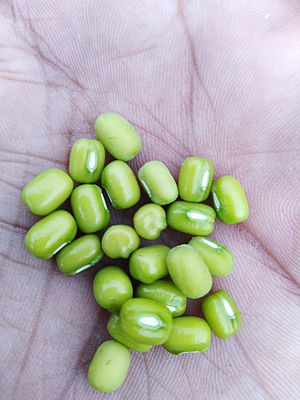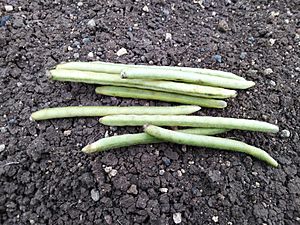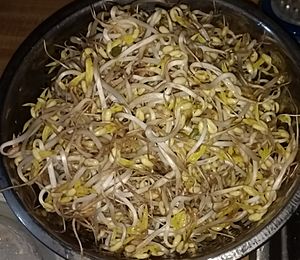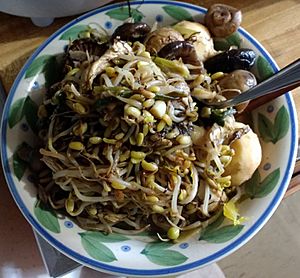Mung bean facts for kids
Quick facts for kids Mung bean |
|
|---|---|
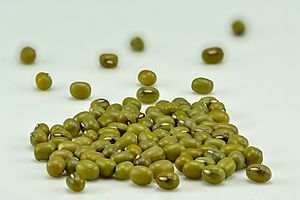 |
|
| Mung beans | |
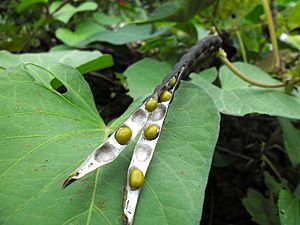 |
|
| Dried and opened mung bean pod | |
| Scientific classification | |
| Genus: |
Vigna
|
| Species: |
radiata
|
| Synonyms | |
|
|
| Nutritional value per 100 g (3.5 oz) | |
|---|---|
| Energy | 1,452 kJ (347 kcal) |
|
62.62 g
|
|
| Sugars | 6.6 g |
| Dietary fiber | 16.3 g |
|
1.15 g
|
|
|
Protein
|
28.86 g
|
| Vitamins | Quantity
%DV†
|
| Thiamine (B1) |
54%
0.621 mg |
| Riboflavin (B2) |
19%
0.233 mg |
| Niacin (B3) |
14%
2.251 mg |
| Pantothenic acid (B5) |
38%
1.91 mg |
| Vitamin B6 |
29%
0.382 mg |
| Folate (B9) |
156%
625 μg |
| Vitamin C |
6%
4.8 mg |
| Vitamin E |
3%
0.51 mg |
| Vitamin K |
9%
9 μg |
| Minerals | Quantity
%DV†
|
| Calcium |
13%
132 mg |
| Iron |
52%
6.74 mg |
| Magnesium |
53%
189 mg |
| Manganese |
49%
1.035 mg |
| Phosphorus |
52%
367 mg |
| Potassium |
42%
1246 mg |
| Zinc |
28%
2.68 mg |
|
Link to USDA Database entry
|
|
| †Percentages estimated using US recommendations for adults. | |
| Nutritional value per 100 g (3.5 oz) | |
|---|---|
| Energy | 126 kJ (30 kcal) |
|
5.94 g
|
|
| Sugars | 4.13 g |
| Dietary fiber | 1.8 g |
|
0.18 g
|
|
|
Protein
|
3.04 g
|
| Vitamins | Quantity
%DV†
|
| Thiamine (B1) |
7%
0.084 mg |
| Riboflavin (B2) |
10%
0.124 mg |
| Niacin (B3) |
5%
0.749 mg |
| Pantothenic acid (B5) |
8%
0.38 mg |
| Vitamin B6 |
7%
0.088 mg |
| Folate (B9) |
15%
61 μg |
| Vitamin C |
16%
13.2 mg |
| Vitamin E |
1%
0.1 mg |
| Vitamin K |
31%
33 μg |
| Minerals | Quantity
%DV†
|
| Calcium |
1%
13 mg |
| Iron |
7%
0.91 mg |
| Magnesium |
6%
21 mg |
| Manganese |
9%
0.188 mg |
| Phosphorus |
8%
54 mg |
| Potassium |
5%
149 mg |
| Zinc |
4%
0.41 mg |
|
Link to USDA Database entry
|
|
| †Percentages estimated using US recommendations for adults. | |
| Nutritional value per 100 g (3.5 oz) | |
|---|---|
| Energy | 441 kJ (105 kcal) |
|
19.15 g
|
|
| Sugars | 2 g |
| Dietary fiber | 7.6 g |
|
0.38 g
|
|
|
Protein
|
7.02 g
|
| Vitamins | Quantity
%DV†
|
| Thiamine (B1) |
14%
0.164 mg |
| Riboflavin (B2) |
5%
0.061 mg |
| Niacin (B3) |
4%
0.577 mg |
| Pantothenic acid (B5) |
8%
0.41 mg |
| Vitamin B6 |
5%
0.067 mg |
| Folate (B9) |
40%
159 μg |
| Vitamin C |
1%
1 mg |
| Vitamin E |
1%
0.15 mg |
| Vitamin K |
3%
2.7 μg |
| Minerals | Quantity
%DV†
|
| Calcium |
3%
27 mg |
| Iron |
11%
1.4 mg |
| Magnesium |
14%
48 mg |
| Manganese |
14%
0.298 mg |
| Phosphorus |
14%
99 mg |
| Potassium |
9%
266 mg |
| Zinc |
9%
0.84 mg |
|
Link to USDA Database entry
|
|
| †Percentages estimated using US recommendations for adults. | |
The mung bean (Vigna radiata) is a small, green plant from the legume family. It is also known as the green gram. People grow mung beans mainly in East Asia, Southeast Asia, and the Indian subcontinent. They are used in many different dishes, both sweet and savory.
Contents
What are Mung Beans?
Plant Description and Names
The green gram is an annual vine. This means it grows and lives for only one year. It has yellow flowers and fuzzy brown pods.
The English word mung comes from the Hindi word "moong". This word itself comes from the ancient Sanskrit word "mudga".
Scientific Classification
Mung beans are part of the Vigna group of plants. Before the 1970s, they were known by different scientific names like Phaseolus aureus. Scientists changed their classification to Vigna radiata.
How Mung Beans are Used
Mung beans are a very popular food in many parts of Asia. They can be used in different forms.
Whole Mung Beans and Paste
Whole mung beans are usually dried first. Then, they are boiled until they become soft. When their green skins are removed, the beans are light yellow. You can also make a paste from mung beans by removing their skins, cooking them, and then grinding them into a dry paste.
Mung Beans in South Asia
In India, people often use mung beans without their skins. In some parts of India, like Karnataka and Tamil Nadu, whole mung beans are boiled. They are often served with rice porridge. This dish is called kanji or pesalu.
Summer Moong is a type of mung bean crop grown in northern India. It grows quickly, so farmers can plant it between other crops. It needs a hot climate to grow well.
In some Indian cuisines, the outer coats of mung beans are removed to make dal. In Bangladesh, this split bean is used to make a soup-like dish called moog dal.
In South India, steamed whole beans are mixed with spices and fresh coconut. This dish is called "pesalu" or "sundal". In Andhra Pradesh, a batter made from ground whole mung beans is used to make a type of dosa called pesarattu.
Mung Beans in East Asia
In Chinese cooking, whole mung beans are used to make a sweet dessert soup called lǜdòu tángshuǐ. This soup can be served warm or cold. Mung beans are also often cooked with rice to make congee (a type of rice porridge).
In Hong Kong, people make ice cream or frozen ice pops from hulled mung beans and mung bean paste. Mung bean paste is also a common filling for Chinese mooncakes in East China and Taiwan. During the Dragon Boat Festival, boiled and shelled mung beans are used as a filling in glutinous rice dumplings.
In Korea, skinned mung beans are soaked and ground into a thick batter. This batter is used to make Korean pancakes called bindae-tteok.
Mung Beans in Southeast Asia
In the Philippines, ginisáng monggó is a savory stew made with whole mung beans, prawns, or fish. It is often eaten on Fridays during Lent.
Mung bean paste is also a common filling for pastries like hopia in Indonesia and the Philippines. In Indonesia, mung beans are made into a dessert snack called es kacang hijau. This is a porridge-like dish cooked with sugar, coconut milk, and ginger.
Mung Beans in the Middle East
In some parts of the Middle East, mung beans and rice are a main food. They are cooked together in a dish called maash wa ruzz, which means "mung beans and rice".
-
Ginisang monggo with ampalaya and shrimp
-
Hopia filled with mung bean paste
-
Korean mung bean pancakes (Korean: 빈대떡) being cooked
-
Mung pakon, traditional Bengali pitha, Bangladesh.
Mung Bean Sprouts
Mung bean sprouts are grown by soaking mung beans in water. They are usually called "bean sprouts". These sprouts are often stir-fried in Chinese cooking with garlic, ginger, or spring onions.
In Vietnam, uncooked bean sprouts are used in spring rolls and as a garnish for phở soup. They are also a key ingredient in many Malaysian dishes like char kway teow.
In Korea, lightly cooked mung bean sprouts, called sukjunamul, are a common side dish. They are quickly boiled, cooled, and mixed with sesame oil, garlic, and salt. In the Philippines, mung bean sprouts are used to make lumpia rolls.
In India, mung bean sprouts are cooked with green chili, garlic, and other spices. In Indonesia, sprouts are used as fillings for dishes like tahu isi (stuffed tofu). In Japan, these sprouts are called moyashi.
Mung Bean Starch
Mung bean starch is taken from ground mung beans. This starch is used to make clear cellophane noodles. These noodles are also known as glass noodles or bean thread noodles. They become soft and slippery when soaked in hot water.
In Korea, a jelly called nokdumuk is made from mung bean starch. In northern China, mung bean jelly is called liangfen. It is a popular food during summer.
Mung bean batter is also used to make crepes called pesarattu in India and pancakes called bindaetteok in Korea.
Plant-Based Protein
Mung beans are becoming more popular in foods that replace meat and eggs. For example, they are used in products like Beyond Meat and Just Egg.
History of Mung Bean Cultivation
Mung beans were first grown by people in India. The wild version of the mung bean (Vigna radiata subspecies sublobata) still grows there.
Scientists have found old mung beans at many ancient sites in India. Some of these finds are from about 4,500 years ago in the Harappan Civilisation. Other finds in South India are more than 4,000 years old. This suggests that mung beans might have been domesticated in two different parts of India. By about 3,500 years ago, mung beans were grown all over India.
Later, cultivated mung beans spread from India to China and Southeast Asia. For example, archaeological research shows that mung beans arrived in Thailand at least 2,200 years ago.
Images for kids
-
Sichuan-style spicy liangfen
See also
 In Spanish: Soja verde para niños
In Spanish: Soja verde para niños



